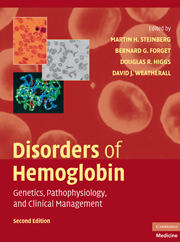Book contents
- Frontmatter
- Contents
- List of Contributors
- Foreword, by H. Franklin Bunn
- Preface
- Introduction, by David J. Weatherall
- SECTION ONE THE MOLECULAR, CELLULAR, AND GENETIC BASIS OF HEMOGLOBIN DISORDERS
- SECTION TWO PATHOPHYSIOLOGY OF HEMOGLOBIN AND ITS DISORDERS
- SECTION THREE α THALASSEMIA
- SECTION FOUR THE β THALASSEMIAS
- SECTION FIVE SICKLE CELL DISEASE
- SECTION SIX OTHER CLINICALLY IMPORTANT DISORDERS OF HEMOGLOBIN
- SECTION SEVEN SPECIAL TOPICS IN HEMOGLOBINOPATHIES
- SECTION EIGHT NEW APPROACHES TO THE TREATMENT OF HEMOGLOBINOPATHIES AND THALASSEMIA
- 29 Transfusion and Iron Chelation Therapy in Thalassemia and Sickle Cell Disease
- 30 Induction of Fetal Hemoglobin in the Treatment of Sickle Cell Disease and β Thalassemia
- 31 Novel Approaches to Treatment
- 32 Stem Cell Transplantation
- 33 Prospects for Gene Therapy of Sickle Cell Disease and Thalassemia
- Index
- Plate section
- References
33 - Prospects for Gene Therapy of Sickle Cell Disease and Thalassemia
from SECTION EIGHT - NEW APPROACHES TO THE TREATMENT OF HEMOGLOBINOPATHIES AND THALASSEMIA
Published online by Cambridge University Press: 03 May 2010
- Frontmatter
- Contents
- List of Contributors
- Foreword, by H. Franklin Bunn
- Preface
- Introduction, by David J. Weatherall
- SECTION ONE THE MOLECULAR, CELLULAR, AND GENETIC BASIS OF HEMOGLOBIN DISORDERS
- SECTION TWO PATHOPHYSIOLOGY OF HEMOGLOBIN AND ITS DISORDERS
- SECTION THREE α THALASSEMIA
- SECTION FOUR THE β THALASSEMIAS
- SECTION FIVE SICKLE CELL DISEASE
- SECTION SIX OTHER CLINICALLY IMPORTANT DISORDERS OF HEMOGLOBIN
- SECTION SEVEN SPECIAL TOPICS IN HEMOGLOBINOPATHIES
- SECTION EIGHT NEW APPROACHES TO THE TREATMENT OF HEMOGLOBINOPATHIES AND THALASSEMIA
- 29 Transfusion and Iron Chelation Therapy in Thalassemia and Sickle Cell Disease
- 30 Induction of Fetal Hemoglobin in the Treatment of Sickle Cell Disease and β Thalassemia
- 31 Novel Approaches to Treatment
- 32 Stem Cell Transplantation
- 33 Prospects for Gene Therapy of Sickle Cell Disease and Thalassemia
- Index
- Plate section
- References
Summary
INTRODUCTION
It has been four decades since the concept of gene therapy for human disease began to be considered and discussed in earnest. With the advent of recombinant DNA technology in the 1970s and the concurrent discovery that viruses could carry novel genetic information into target cells, gene therapy was seen as having significant future potential. A major step in the development of gene therapy for hematopoietic disorders occurred in 1985 when the laboratories of Bernstein and Anderson simultaneously showed that the genome of mouse hematopoietic stem cells (HSCs) could be permanently modified using a genetically engineered retrovirus capable of integrating into host cell DNA. These results suggested that a patient's own HSCs could be harvested, genetically modified ex vivo, and then returned, perhaps following administration of radiation or chemotherapy to eradicate the diseased HSCs. From that time, it took almost a decade before functional correction of human disease model was demonstrated using retroviral-mediated, HSC-targeted gene transfer. The first such description was that of Heard and colleagues when they demonstrated the successful treatment of a murine model of the lysosomal disorder, mucopolysaccharidosis type VII. Subsequently, murine models of two immunodeficiencies – chronic granulomatous disease and a form of severe combined immunodeficiency due to JAK3 deficiency – were also successfully treated using gene therapy. These successes seemed to fulfill the stated goals of the Orkin and Motulsky NIH panel, which called for more basic science research into gene therapy and the use of murine disease models to demonstrate efficacy prior to clinical trials.
- Type
- Chapter
- Information
- Disorders of HemoglobinGenetics, Pathophysiology, and Clinical Management, pp. 791 - 814Publisher: Cambridge University PressPrint publication year: 2009



